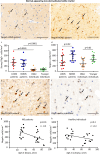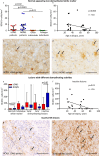Impaired remyelination in late-onset multiple sclerosis
- PMID: 40167776
- PMCID: PMC11961469
- DOI: 10.1007/s00401-025-02868-5
Impaired remyelination in late-onset multiple sclerosis
Abstract
A reduced regenerative capacity may contribute to faster disease progression and poorer relapse recovery in multiple sclerosis patients with disease onset after the age of 50, a condition known as late-onset multiple sclerosis (LOMS). We hypothesized that lesions in LOMS patients show more pronounced axonal damage, less remyelination and an altered inflammatory composition, and performed a detailed histopathological analysis of MS biopsies in patients with early-stage LOMS. The number of T cells, B cells, plasma cells, microglia/macrophages, different oligodendrocyte populations as well as the axonal density and acute axonal damage were assessed in 31 LOMS and 30 normal-onset MS (NOMS, 20-40 years old) patients. No major differences in the inflammatory infiltrate or axonal damage were found. BCAS1-positive oligodendrocytes indicating early myelinating oligodendrocytes, and mature oligodendrocytes were significantly lower in the normal-appearing white matter of LOMS compared to NOMS patients (p = 0.05; p = 0.01), with a negative correlation with age (r = - 0.5, p = 0.01). In active demyelinating lesions, the number of BCAS1-positive oligodendrocytes did not differ between LOMS and NOMS, but NOMS lesions showed a higher proportion of ramified cells indicating active remyelination. In LOMS, BCAS1-positive oligodendrocytes decreased with increasing lesion age, with the lowest numbers found in inactive demyelinated lesions. In contrast, NOMS patients showed high numbers of BCAS1-positive cells with an activated morphology, even in inactive demyelinated lesions. At the last follow-up, LOMS patients had a significantly higher EDSS score (median 3.5) than NOMS patients (median 3.0, p = 0.05). A higher EDSS score correlated with fewer mature and oligodendrocyte precursor cells in active demyelinating lesions (r = - 0.4, p = 0.01 and r = - 0.6, p = 0.003). These findings suggest a clinically relevant impaired oligodendrocyte differentiation and remyelination in LOMS. Since remyelination is essential for axonal protection, it will be necessary to consider the complex and dynamic tissue environment when researching therapeutics aimed at fostering the differentiation of oligodendrocyte precursor cells into myelinating oligodendrocytes.
Keywords: Acute axonal damage; Axonal density; BCAS1; Inflammation; Late-onset multiple sclerosis; Oligodendrocytes; Remyelination.
© 2025. The Author(s).
Conflict of interest statement
Declarations. Conflict of interest: LS: reports funding from Sanofi outside the submitted work; SS has nothing to disclose; AK: has nothing to disclose; IM: reports funding from Sanofi for this study. IM reports personal fees from Biogen, Bayer Healthcare, TEVA, Serono, Novartis, Sanofi, Roche, BMS, Neuraxpharm as well as grants from Biogen outside the submitted work.
Figures





References
-
- Barateiro A, Fernandes A (2014) Temporal oligodendrocyte lineage progression: in vitro models of proliferation, differentiation and myelination. Biochem Biophys Acta 1843:1917–1929. 10.1016/j.bbamcr.2014.04.018 - PubMed
-
- Bramow S, Frischer JM, Lassmann H, Koch-Henriksen N, Lucchinetti CF, Sørensen PS et al (2010) Demyelination versus remyelination in progressive multiple sclerosis. Brain 133:2983–2998. 10.1093/brain/awq250 - PubMed
-
- Bruck W, Popescu B, Lucchinetti CF, Markovic-Plese S, Gold R, Thal DR et al (2012) Neuromyelitis optica lesions may inform multiple sclerosis heterogeneity debate. Ann Neurol 72:385–394. 10.1002/ana.23621 - PubMed
Publication types
MeSH terms
Grants and funding
LinkOut - more resources
Full Text Sources
Medical

